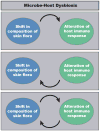What Lives On Our Skin: Ecology, Genomics and Therapeutic Opportunities Of the Skin Microbiome
- PMID: 24273587
- PMCID: PMC3833721
- DOI: 10.1016/j.ddmec.2012.12.003
What Lives On Our Skin: Ecology, Genomics and Therapeutic Opportunities Of the Skin Microbiome
Abstract
Our skin is home to a rich community of microorganisms. Recent advances in sequencing technology have allowed more accurate enumeration of these human-associated microbiota and investigation of their genomic content. Staphylococcus, Corynebacterium and Propionibacterium represent the dominant bacterial genera on skin and illustrate how bacteria adapt to life in this harsh environment and also provide us with unique benefits. In healthy states, our skin peacefully co-exists with commensal bacteria while fending off potentially dangerous invaders. Disruption of this equilibrium, termed "dysbiosis", can result from changes in the composition of our skin bacteria, an altered immune response to them, or both and may be a driving factor in certain types of inflammatory skin disease. Engineering topical therapeutics to favourably influence the composition of our skin flora and optimize interactions with them represents a real therapeutic opportunity for the field of dermatology and warrants additional investigation into skin microbial ecology and disease mechanisms related to host-microbe dysbiosis.
Conflict of interest statement
The authors have no conflict of interest to declare.
Figures


References
-
- Savage DC. Microbial ecology of the gastrointestinal tract. Annu Rev Microbiol. 1977;31:107–133. - PubMed
Grants and funding
LinkOut - more resources
Full Text Sources
Other Literature Sources
